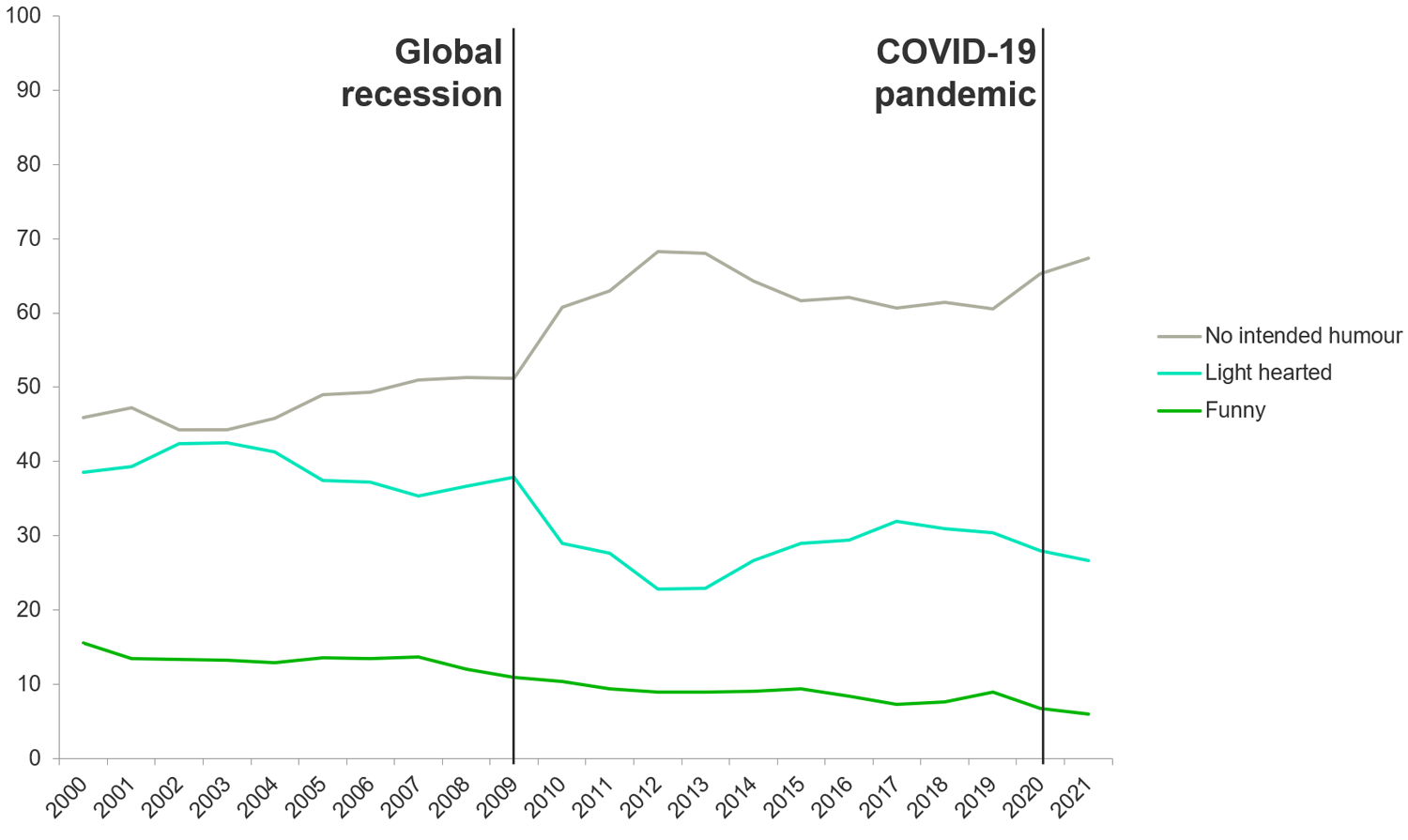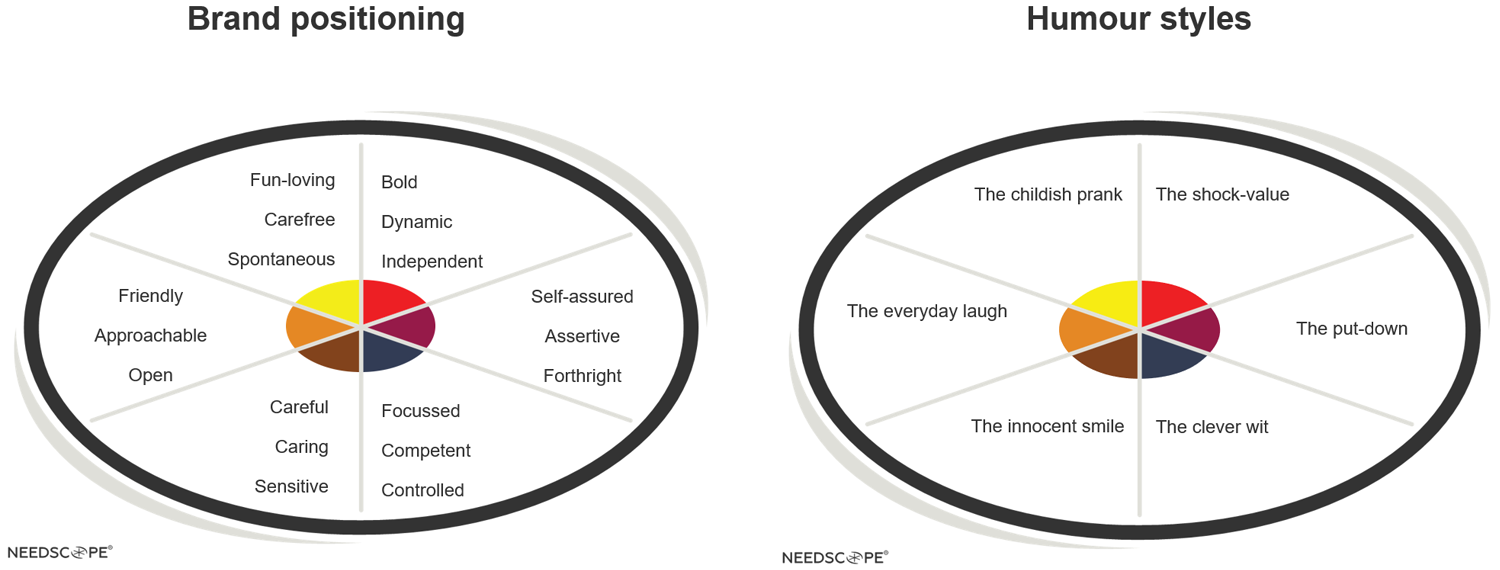Kantar’s AdReaction study showed that humour is the most powerful creative enhancer of receptivity. And it crosses the generations. Our Link ad testing database also shows that not only is it a great way to get a reaction, but it can make your advertising really stand out from the crowd. Humorous ads are more expressive (+27 point increase), more involving (+14) and more distinct (+11).
Only 33% of the ads we research at Kantar incorporate some form of humour, yet half of our Kantar Creative Effectiveness Award winners use it.
Humour is used more often in TV ads (37%) than other channels (15% of print/outdoor and 28% amongst digital ads). We also see variance across digital media: 12% of website ads, 24% of Facebook/Instagram ads, and 30% of YouTube ads use humour in some way.
The decline in use of humour
The last twenty years have seen a steady decline in the use of humour in advertising, and the pandemic has accelerated this decline. Why is this? Do we live in a more serious world? No. Regardless of what’s going on, there is, and has always been, room for humour in the world.
What has changed is an increased fear of using humour inappropriately.
Even during the pandemic, Kantar’s COVID-19 Barometer showed that people still wanted to see humour in advertising. In fact, people wanted it more than ever to help bring back some normality to their lives.
The use of humour has declined

Source: Kantar Link database
In a world of mass media overload, we want to watch things that entertain us, and better still, make us laugh... even if they happen to be ads.
Getting humour right
In a constantly evolving world, where levels of appropriateness fall on a transient scale, it is wise to be mindful of the type of humour you use. It is essential that it is not only relevant to your target audience, but also appropriate to the media context. Humour offers a great opportunity to humanise your brand and build affinity. In the same way the friends who make you laugh are often those you are closely bonded with, brands that connect with their consumers through humour also bond with them.
Bonding comes from emotion, and it is important to ensure that the natural flow of ‘emotion’ through your brand’s touchpoints is clear and aligned, making for a well-executed brand strategy. Kantar’s NeedScope model captures the different kinds of emotion that exist in a category, helping brands choose the emotion around which they want to anchor their brand. It’s the same when thinking about the type of humour you should use: it should be aligned with the emotions you are targeting with your brand.
Six emotive spaces form the basis of brand positioning and six humour styles align ads on emotion

The emotional connection that humour builds helps people remember your advertising. We allow ‘mental availability’ for something that entertains us, and if your brand is an intrinsic part of that humour, people are more likely to remember, notice, recognise and buy your brand.
Whilst humorous ads tend to be more engaging and distinctive, ads that make viewers laugh out loud are naturally more enjoyable and likely to be shared. However, linking humour to the brand is an important part of the puzzle. There is no direct relationship between humour and remembering the brand, even when the humour is laugh out loud funny. But when the brand is at the centre of the joke, such as in this winning Cannes ad for Busch beer, branded memorability can be incredibly strong.
Humour also needs to be used judiciously to ensure it doesn’t distract from communication, as this can impede persuasion. The danger lies in losing your ad’s core message in the humour. If you have new information to convey, it can be beneficial to build the humour around that message.
Targeting humour
Globally, we don’t see many differences in how humour is enjoyed by gender or age. Differences are more likely to be influenced by the type of humour used. In markets where slight differences are seen, we believe this is more to do with the type and styles of advertising used in the region rather than real differences amongst viewers.
Funny writing is difficult, and this is apparent with more brands turning to professional comedians to write comedy into their ads. Comedians ‘test’ humour and know what works and what doesn’t across different audiences, and those who perform globally are aware of what may be lost in translation. Funny ads that can cross borders tend to use physical or visual humour (think ‘Mr Bean’). Humour that is all about context can be lost if the shared knowledge is not there across markets.
Professional comedians also know how to write concisely. They find clever ways to expose the reality of things, and the good ones will find a way to do that whilst making people care about your brand. They are well placed to set the right tone to target the audience you are after.
What style of humour should you use?
Visual or slapstick humour is used most often in advertising. Around 45% of ads rely on this type of humour. Other styles can be used in specific ways, for example word-play humour, when done well, can help with branding if cleverly connected to the brand name. Dark, or black humour, although rarely used (only 1% of ads take this risk) can, if successful, be impactful, creating strong engagement and branded memorability.
The explosion of social media has resulted in an evolution of new types of humour, with breakaway niche groups developing new styles across different platforms. Brands need to know their target audience well, and that means more than knowing their socio-economic status, age and gender. To bring your audience on board with humour, it is essential that the style used will hit the mark and be appropriate for where it will be seen. The evolution of existing platforms and the astonishing rise of new ones like TikTok means this is a topic under constant review.
Humour styles can vary wildly across platforms. There will always be content that passes smoothly from one platform to the next, but definite humour types are evolving on some of the newer platforms. There is the ‘pun’ style humour on Snapchat, where words are often written across an associated visual. The risqué nature of the content is often heightened by the disposable nature of material on this platform.
TikTok’s humour is fast-moving and often satirical. Short videos use condensed humour, which can be as much about brand development as about making people laugh. TikTok has a diverse cross-breed of comedians, influencers and creators who know about editing audio-visual content for maximum effect.
Facebook/Instagram humour is often more personal, and as such can help create emotional connections as content is shared amongst friends. YouTube humour can range from a full comedy to a ‘You’ve Been Framed’ style clip, but tends to be more story based and longer than other platforms. Humorous clips that have gone viral on YouTube are sometimes picked up and used by brands.
What’s the future of humour in advertising?
Hopefully, it will be used more often. With numerous lockdowns and live shows cancelled, now might be a better time than ever to engage professionals in your use of humour. Alongside professional comic writers, look out for popular content creators on the platforms your target audience use most. They will be in tune with the humour types that resonate. Be prepared to move with them and across them as popularity rates rise and fall.
Social media platforms and user-generated content have made the humour of the masses more accessible to all, and this has led to a wider range of styles that can suit the most specific of niche audiences. Using humour with exacting precision may indeed be a way for brands to connect and bond with their consumers on a whole new level.
So be brave (being funny requires courage, as any stand-up comedian will tell you) and join the brands that are bold enough to bring humour back to their advertising. After the recent years of purpose-driven, heartfelt, emotional advertising and ‘sadvertising’, it may be time to give people something to laugh about.
With Kantar’s ad testing and media solutions to check you have it right, there has never been a better time to use humour to truly connect with your consumers.


